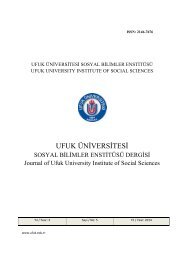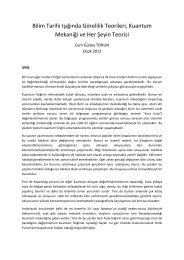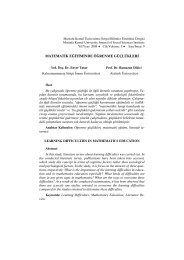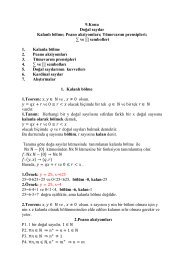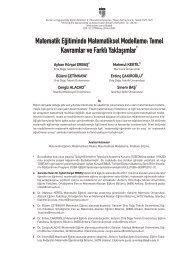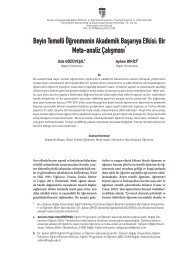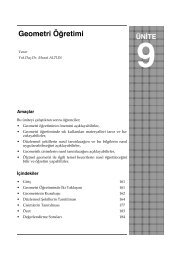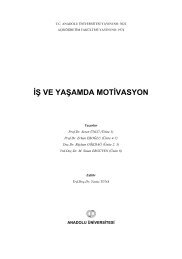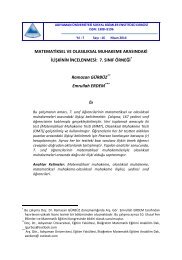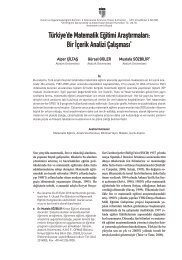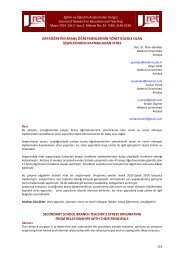bd798f7e557c386e7e231ced888acec57061
bd798f7e557c386e7e231ced888acec57061
bd798f7e557c386e7e231ced888acec57061
- No tags were found...
You also want an ePaper? Increase the reach of your titles
YUMPU automatically turns print PDFs into web optimized ePapers that Google loves.
ferent countries is strongly affected by social and<br />
cultural factors that shape beliefs, aims, teaching<br />
methodologies and expectations. Different cultures<br />
and societies follow different philosophies for<br />
teaching and learning mathematics. The variety in<br />
values and beliefs regarding mathematics education<br />
leads to diversity in education systems across<br />
countries (An, Kulm, Wu, Ma, & Wang, 2006). In<br />
this respect, the purpose of the current study is to<br />
examine the underlying values of Turkish and German<br />
Mathematics teachers’ decision making processes<br />
for the problems/situations they encounter<br />
in a learning environment. For this purpose, the<br />
study tries to determine what underlying values affect<br />
teachers’ decisions while forming groups when<br />
a group study is planned to teach any subject in a<br />
mathematics lesson. As a matter of fact, group and<br />
collaborative learning environments can contribute<br />
to the attainment and development of better individual<br />
decision-making skills (Clemen & Hampton,<br />
1994; Gregory & Clemen, 1994) and such environments<br />
can ease the understanding of principles<br />
and processes related to decision-making context<br />
(Clemen & Hampton).<br />
In mathematics education, there exist articles and<br />
projects that note the place and importance of values<br />
in the literature (e.g., Dede, 2009, 2011; Values<br />
in Mathematics Teaching [VIMT]) and Values and<br />
Mathematics Project [VAMP], etc.). However, no<br />
study that investigates the underlying values of<br />
teachers’ decisions for the problems/situations they<br />
encounter in a learning environment is encountered<br />
in the literature. Nonetheless, a limited number<br />
of studies that examine values that lie behind<br />
effective mathematics teaching according to the<br />
views of students and teachers appear in the literature<br />
(see Seah, 2011b). Consequently, it is essential<br />
to uncover the underlying values of mathematics<br />
teachers in culturally, socially and educationally<br />
different countries such as German and Turkey and<br />
their decision making processes as well as the factors<br />
that affect these values. As mentioned before,<br />
different cultures have different values and even<br />
the same mathematical content is taught with different<br />
teaching methodologies and approaches in<br />
different cultures (Seah, 2003b) and values affect<br />
teachers’ preferences, behaviors (Yero, 2002) and<br />
decisions (Fasheh, 1982). Hence, if teachers’ values<br />
are recognized, the reasons behind their classroom<br />
practices, preferences, decisions, and behaviors<br />
can be understood better. That is why, this study<br />
reports only some parts of the findings of a wide<br />
range project (Values in Mathematics Teaching<br />
in Turkey and Germany -VMTG) which analyses<br />
mathematical values of Turkish and German mathematic<br />
teachers and students, and specifically seeks<br />
answers to the question below:<br />
What are the underlying values of Turkish and<br />
German teachers’ decision making processes during<br />
classroom practices (formation of groups)<br />
Research Design<br />
Method<br />
This paper is based on the findings of VMTG project.<br />
Briefly, the purpose of VMTG project was to<br />
determine the values of Turkish and German teachers<br />
and students. VTMG project adopted sequential<br />
mixed method research design in which quantitative<br />
and qualitative research methods were used<br />
together. Quantitative methods helped to make statistical<br />
deductions and interpretations with regard<br />
to the relations between concepts while qualitative<br />
methods enabled flexibility and ensured to acquire<br />
in-depth information about the concepts investigated<br />
in the research (Punch, 1998). Depending<br />
on the aims and characteristics of phases of VMTG<br />
project, this study employed a wide range of sampling<br />
methods together. It made use of convenience<br />
and purposeful sampling methods for quantitative<br />
data and purposeful and theoretical sampling<br />
methods for qualitative data. The reasons behind<br />
the use of sequential mixed method research design<br />
are as follows: (a) sequential mixed method is<br />
a research design that compensate for the limitations<br />
of one research method by the strengths of<br />
another research method to increase the reliability<br />
of the findings (Rudestam & Newton, 2007) and (b)<br />
in this study, since progress is the aim of sequential<br />
mixed method, the use of sequential mixed method<br />
is appropriate. This is because progress includes<br />
the sequential use of method in such a way that the<br />
findings of the former research method set ground<br />
for the use of the latter research design (Onwuegbuzie<br />
& Collins, 2007). In the VMTG project, the<br />
first phase of this method was the quantitative data<br />
collection (with the use of a Likert-type scale) and<br />
analysis. In the second phase, based on the findings<br />
of the quantitative data, qualitative data were<br />
gathered (by the means of semi-structured interviews,<br />
classroom observations, document analysis,<br />
the open-ended question form and field notes, etc.)<br />
and analyzed. In this way, quantitative data and<br />
findings were used to produce necessary content<br />
for the qualitative data and analyses, so that the<br />
analysis of quantitative data were integrated with<br />
the qualitative data analysis. However, the pres-





